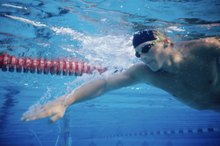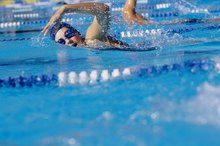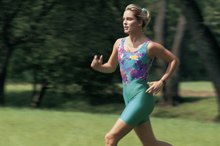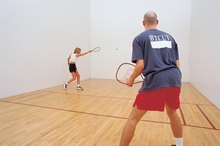What does fact checked mean?
At Healthfully, we strive to deliver objective content that is accurate and up-to-date. Our team periodically reviews articles in order to ensure content quality. The sources cited below consist of evidence from peer-reviewed journals, prominent medical organizations, academic associations, and government data.
The information contained on this site is for informational purposes only, and should not be used as a substitute for the advice of a professional health care provider. Please check with the appropriate physician regarding health questions and concerns. Although we strive to deliver accurate and up-to-date information, no guarantee to that effect is made.
Calories Burned by Pool Running Vs. Land Running
Although running on land is more widely performed than running in a pool, aqua running is gaining in popularity, reports "The Sunday Times." When done consistently and correctly, both modes of running effectively burn calories.
Calories
A calorie is the amount of heat required to raise the temperature of 1 gram of water by 1 degree. Nutritionally speaking, a calorie is a unit of energy that is supplied by food. In order to lose 1 pound of body fat, you must reduce your normal, needed caloric intake by 3,500 calories. Metabolism is the process of breaking down food for use as energy. Increasing activity, such as adding running to a fitness regimen, increases metabolism and thereby helps reduce calories. The Centers for Disease Control and Prevention recommends performing at least two hours and 30 minutes of moderate-intensity aerobic activity per week 2.
- A calorie is the amount of heat required to raise the temperature of 1 gram of water by 1 degree.
- In order to lose 1 pound of body fat, you must reduce your normal, needed caloric intake by 3,500 calories.
Land Running
Ankle Pain & Swimming
Learn More
Running on land is a high-impact activity. Injuries can occur as a result of the stress put on the body, particularly the knees, legs and feet. When running on land, wear proper-fitting shoes that are not worn out. Use proper running form to not only avoid injuries, but also to improve efficiency. All movement should be forward without bouncing or hopping.
- Running on land is a high-impact activity.
- When running on land, wear proper-fitting shoes that are not worn out.
Aqua Running
Running in water has been used by physiotherapists since the 1980s to help rehabilitate injured athletes. Water cushions the body and is gentler on joints than hard surfaces. According to the 2000 article Dr. Robert Wilder of the University of Virginia School of Medicine, published in the “Charlottesville and Albemarle Observer,” aqua running closely simulates land running in intensity yet provides a lower impact on the body 3. To maintain proper form when aqua running, the water should be at shoulder-level with your mouth out of the water. You should look straight ahead, your body slightly forward with hands clenched, your arms should be positioned as if running on land and your feet should not touch the bottom of the pool. Finally, your leg motion should also be the same as with land running. Use a vest or belt for buoyancy.
- Running in water has been used by physiotherapists since the 1980s to help rehabilitate injured athletes.
- You should look straight ahead, your body slightly forward with hands clenched, your arms should be positioned as if running on land and your feet should not touch the bottom of the pool.
Burning Calories
How to Tread Water for Weight Loss
Learn More
According to Wilder, running on land burns approximately 8 calories in one minute. Running in water burns approximately 11.5 calories in the same amount of time. He attributes this difference to water resistance and the fact that an aqua runner must work the upper body more than a land runner. Other factors that affect calorie burn are the intensity and duration of the running, body weight, degree of fitness and metabolism. A person weighing 130 pounds will generally burn fewer calories than a person weighing 180 pounds doing the exact same activity.
- According to Wilder, running on land burns approximately 8 calories in one minute.
- He attributes this difference to water resistance and the fact that an aqua runner must work the upper body more than a land runner.
Related Articles
References
- “The Sunday Times”; Water Works; Peta Bee; September 22, 2007
- Centers for Disease Control and Prevention: Balancing Calories
- University of Virginia School of Medicine: Deep Water Running for Athletic Rehabilitation
- Killgore GL. Deep-water running: a practical review of the literature with an emphasis on biomechanics. Phys Sportsmed. 2012;40(1):116-26. doi:10.3810/psm.2012.02.1958
- Killgore, GL. Deep-Water Running: A Practical Review of the Literature With an Emphasis on Biomechanics. The Physician and Sportsmedicine. 2014;40(1):116-126. doi:10.3810/psm.2012.02.1958.
Resources
Writer Bio
Colette Kelly Logan has been writing about health care since 2005. For several years, she managed two oncology reimbursement hotlines, answering questions from oncology professionals. Logan has also written and co-presented live health-care webinars. She holds a B.A. in English from Saint Leo University.









